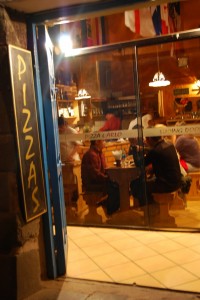Pizza Carlo, Charm and Good Pies

Pizza is so common in Cuzco that is seems more present, at least in the tourist areas of town, than ceviche or pollo a la brasa. Yet there is quite a variation in quality and technique, though the pizzas have improved enormously over the last decade. Nevertheless, one small place, Pizza Carlo (Maruri 381) offers a quality pie that stands high above most of the rest.
Of course, Italian food is part of Peru’s heritage. In the nineteenth century it had a substantial immigration of Italians, mostly from Liguria, who had a lasting impact on what became known as “creole” cuisine. Manifested in the influence of pasta, sauces, and Christmas breads (panetones), the Ligurian influence did not lead to pizza, per se, in Cusco.
But it did in Lima, the nation’s capital and largest city. There, where influences from al; over the globe flow and mix, as befits a large city on the coast with a major port (Callao) and airport, pizzerias appeared “in every neighborhood,” as Maria Angelica Matarrazos de Benavides writes.
Though brought through the movement of Ligurians and other Italians, and influenced by connections with Argentina where Italian culture comes close to being a type of national culture, Pizza in Lima also was influenced by the boom of tossed pies in the sixties and seventies.
But they were still rare in Cuzco. The migration of Cusqueños to Lima and the tourist trade had yet to lead to pizza in the Incas’ Imperial City.

Nevertheless, in the eighties they began to appear, especially in the hordes of restaurants along Plateros and Procuradores streets,that open off the Plaza de Armas, the main square. Despite the best efforts of restauranteurs and local cooks, as well as the adobe ovens they quickly threw together, the pizzas were not very good, though they were served with the garlic cream, hot sauce, and crumbled dried oregano on teh side common in Lima.

Since then, as pizza making has become more discussed in the international cooking media and concern developed for a more Italian standard in crusts and ingredients, a new wave of restaurants opened in Cuzco, including ones focused on pizzas.
Pizza Carlo is one of the best of these. Located on the corner of Maruri and San Agustin streets, a block off the Plaza de Armas and halfway between it and the popular Qori Cancha–temple of the sun also known as the monastery and church of Santo Domingo, PIzza Carlo is a single room behind sliding glass doors in an Inca stone wall.
During Cuzco’s chilly nights its warmth from its size and the domed, wood-burning oven in a corner makes one feel good. Unlike many places, the pizza is made right there, in the same room with the guests on a wood credenza that occupies the back wall.
While clients sit at the large picnic-style table or at the few smaller tables in the room, the white-aproned young man takes a ball of dough and rolls it to size before adding the appropriate ingredients and sliding it into the oven.
A friendly, bearded gentleman who many people think is the Carlo of the pizzeria’s name will come over to take your order and, if lucky, tell you about his days living in Europe. specifically Switzerland. He is not Carlos, that was his father who owned the building in which the restaurant is located.
This man is named Johan in that internationalism that today has many of Cuzco’s women named Fiorela–little flower in Italian–and young men named Jhon where the “h” following local aesthetics migrates to stand before the “o” in this most common of English names. He may tell you how he learned about pizzas in Europe and came home to open a restaurant.
The pie will come to your table on a wooden round steaming and well scented. This crust has some of the elasticity one has come to expect in fine contemporary pizzas as well as a depth of flavor unusual for Cuzco.
The toppings are also selected with care and well placed. This is not an American pizza with its overabundance of dripping cheese and sauce mounded high with stuff. Instead it is a pie which seeks a balance.
PIzza Carlo’s menu is creative. Not only does it have standards, such as the Margherita M (Margarita on their menu in Spanish) and the Neapolitan (Napolitana), it also has ones that strike delight, such as the Caprichosa (Spanish for a moody woman who changes her mind frequently) which has, among other things cucumbers. Ok, you might be surprised by that, but try the pizza. It is very good.
This is Pizza Carlo, a warm place with what in Spanish is called cariño, human warmth and care, as well as what may be some of the best pizza in Cuzco.




